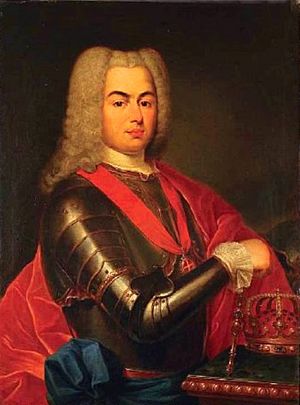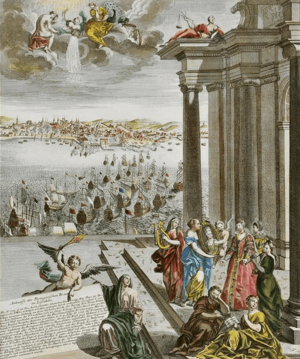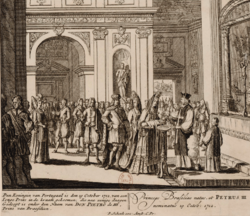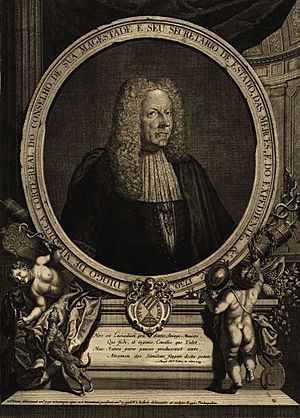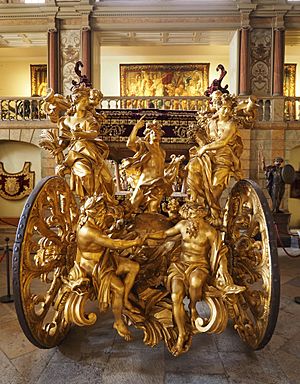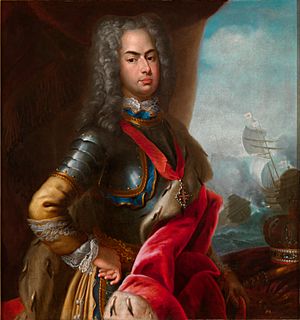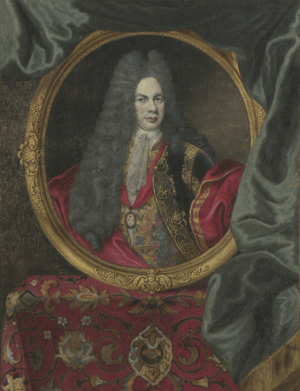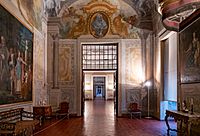John V of Portugal facts for kids
Quick facts for kids John V |
|||||
|---|---|---|---|---|---|
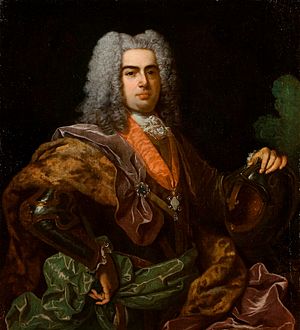
Portrait by Jean Ranc, c. 1729
|
|||||
| King of Portugal (more...) | |||||
| Reign | 9 December 1706 – 31 July 1750 | ||||
| Acclamation | 1 January 1707, Lisbon | ||||
| Predecessor | Peter II | ||||
| Successor | Joseph I | ||||
| Born | 22 October 1689 Ribeira Palace, Lisbon |
||||
| Died | 31 July 1750 (aged 60) Ribeira Palace, Lisbon |
||||
| Burial | Pantheon of the Braganzas | ||||
| Spouse | Maria Anna of Austria | ||||
| Issue among others... |
|
||||
|
|||||
| House | Braganza | ||||
| Father | Peter II of Portugal | ||||
| Mother | Maria Sophia of Neuburg | ||||
| Religion | Roman Catholicism | ||||
| Signature |  |
||||
Dom John V (born João Francisco António José Bento Bernardo; October 22, 1689 – July 31, 1750) was the King of Portugal from 1706 until his death in 1750. He was known as the Magnanimous (meaning "generous" or "great-souled") and the Portuguese Sun King. During his time as king, Portugal and its royal family became very wealthy and respected among other European countries.
John V's rule saw a huge amount of gold flow into the royal treasury. This gold came mostly from a tax called the "royal fifth," which was collected from Portugal's colonies in Brazil and Maranhão. King John spent a lot of this money on grand building projects, especially the famous Mafra Palace. He also bought many art pieces and books for his large collections. To make Portugal more recognized internationally, he spent large sums on special visits (embassies) to other European royal courts, like the famous ones he sent to Paris in 1715 and Rome in 1716.
King John V ruled as an absolute monarch. This means he made all the decisions himself, without needing to ask for permission from a parliament or other government groups. He also wanted Portugal to be involved in what was happening in other European countries, especially during the War of the Spanish Succession. In his empire, John V wanted to expand Portugal's lands, and he gained new territories in Portuguese India and Portuguese America.
John V was a very religious man. He spent a lot of his day praying and studying religious texts. When Pope Benedict XIV officially recognized him as a rightful king, John showed his strong devotion to the Catholic Church by making very large donations. The Pope even gave John V the special title "Most Faithful Majesty," which he really liked. However, John's relationship with the Pope changed over time, with periods of close friendship and times of disagreement.
Contents
Early Life

John was born on October 22, 1689, at Ribeira Palace in Lisbon. He was the second son of King Dom Peter II and Maria Sophia of Neuburg. He was given the full name John Francis Anthony Joseph Benedict Bernard. His parents had another son named John the year before, but that prince had died shortly after birth. So, the court was very happy to have a new male heir. At his baptism, John was not immediately given the usual titles for the heir to the Portuguese throne, Prince of Brazil and Duke of Braganza. This was done out of respect for his older brother who had passed away.
Education and Growing Up
John had a rich childhood, surrounded by some of the smartest people in Europe. It was a tradition at the Portuguese court for young princes to be cared for only by women. John's governess was Maria de Lencastre, Marquise of Unhão. She was chosen more for her high status than for her skills with children.
Because of his father's good decisions, the Portuguese court was wealthy, the country's economy was stable, and the military was strong. This allowed John to have a very interesting childhood. As a child, he was taught by Jesuit priests who taught him about military affairs, politics, astronomy, sailing, math, and history. As he got older, a well-known Portuguese diplomat named Luís da Cunha mentored him in political matters.
When John was seven, his father decided to take over his sons' education himself, though he soon lost interest. John and his brother Francisco were made members of the Order of Christ in 1696. Later that year, John finally received the titles of the heir apparent: Prince of Brazil and Duke of Braganza. A grand ceremony was held on December 1, 1696, where John was officially given his titles.
Just before John's tenth birthday in 1699, his mother, Queen Dona Maria Sofia, died at age 33. This made John very sad and he stayed away from court for many months. His aunt, Dona Catherine of Braganza, who used to be the queen of England, then took charge of his education. She lived in her own palace, Bemposta Palace, and was John's main female role model until she died in 1705.
In April 1700, John became very sick, and people thought he might die. But to everyone's surprise, he got better and returned to his normal activities. His full recovery was seen as a miracle.
John was also very sad when his sister Teresa Maria died in 1704. He avoided court for a few months and felt distant from his father, who seemed to prefer John's younger brother, Manuel. People worried if John would ever recover from his sadness. But in May of that year, he returned to court and made up with the King, saying his sadness would not stop him from doing his duty.
Becoming King
In December 1706, King Peter II became very ill and moved to a royal country house. On December 5, he got a high fever, and doctors said his health was getting much worse. The next day, Peter called all his children to his bedside and told them he was dying. He made John the temporary ruler of the kingdom and asked all his children to follow John's wishes. The King still favored his youngest son, Manuel, and gave him a special gift.
The Acclamation Ceremony
Peter II died on December 9, 1706. After his death, Ribeira Palace was decorated in black to show mourning. A month later, it was decided that John should officially be made king. The palace was redecorated again, with red banners and fruit wreaths.
On January 1, 1707, the day John became king, his new throne was placed on the balcony of the "King's Tower" at Ribeira Palace. Special tapestries showing Justice and Prudence were hung to remind people of the qualities their new king would have. When John sat on his throne, gold wreaths were placed around it. He wore his Cross of the Order of Christ, and the Portuguese Crown Jewels were placed beside him, not on him, as was the Portuguese custom. John was then officially declared "His Majesty, by the Grace of God, King of Portugal and the Algarves, before and beyond the sea in Africa, Lord of Guinea and of Conquest, Navigation, and Commerce of Ethiopia, Arabia, Persia, and India, our Lord, John, the fifth of that name in the table of the Kings of Portugal."
John was now king of an empire that reached across four continents. He was also the leader of a country that was at war with Spain and France. His first act as king was to keep Portugal in the League of Augsburg and continue fighting alongside England and the Habsburgs. Portugal sent more troops to help its allies. This increased involvement allowed John's general, António Luís de Sousa, Marquis of Minas, to capture Madrid in 1706. Although Portugal put a lot of effort into the war, John soon lost interest as he had other important matters to deal with.
Royal Marriage
Before he died, John's father, Peter II, had worked hard to arrange a marriage for John with an Austrian archduchess. This was to make sure Portugal stayed allied with the Habsburgs. John continued these talks and finally made a deal. On June 27, 1707, a marriage contract was signed between John and Holy Roman Emperor Joseph I's sister, Archduchess Maria Anna of Austria. Her dowry (money or property brought by a bride to her husband) was a huge sum of 100,000 crowns.
The ships Portugal sent to bring Maria Anna from the Netherlands arrived in Lisbon on October 26, 1708. Maria Anna's ship docked at the private garden of Ribeira Palace, where John and many important nobles met her. The wedding celebrations were very grand and expensive, lasting until December 27.
By late 1710, John and Maria Anna still did not have a child to inherit the throne. The court began to worry about the future of the House of Braganza. In early 1711, the King met with a Franciscan Cardinal, Nuno da Cunha e Ataíde, who told him that if he promised God to build a Franciscan convent in Mafra, God would give him the heir he wanted. John agreed, promising to build the convent if Maria Anna became pregnant by the end of 1711. His wish came true when Maria Anna gave birth to a daughter, Maria Barbara, on December 4, 1711.
John and Maria Anna had a successful marriage, but they lived mostly separate lives. Maria Anna focused on royal court manners and her religious interests. John, on the other hand, pursued whatever pleased him at the moment. He had many mistresses during his reign.
John V's Children
After Maria Barbara, a son, Pedro, Prince of Brazil, was born on October 19, 1712. This gave John a male heir for a while. Prince Pedro's death in 1714 saddened the King, but he found comfort in the birth of another son, Infante Joseph, who was born earlier that year. After Joseph, three more children were born to John and Maria Anna: Carlos (1716), Pedro (1717), and Alexandre (1723). Only Carlos and Pedro lived to be adults, and only Pedro continued the royal family line.
John's children were trained very strictly as they grew up. He wanted an intelligent son to be king, a daughter married strategically, and other sons to be good statesmen. He achieved some of these goals. From her birth, Infanta Maria Barbara's marriage was carefully planned by John. He even suggested her as a bride for Louis XV of France, but she was not chosen. However, John still benefited from this. His heir, Prince José, became engaged to Mariana Victoria of Spain, and Maria Barbara married Mariana Victoria's older half-brother, Prince Don Ferdinand (who later became King Don Ferdinand VI of Spain).
Negotiations between Portugal and Spain began in 1725. Four years later, John's oldest children were matched with their future spouses. Maria Barbara and Mariana Victoria were exchanged in a ceremony called the Exchange of the Princesses on January 19, 1729. Prince José married Mariana Victoria that same day, and Infanta Maria Barbara married Prince Ferdinand the next day.
None of John's other three sons married during his lifetime. Infante Alexandre died at age five, and Infante Carlos died at age twenty without marrying or having children. Only Infante Pedro lived long enough to marry, but John did not see it. Pedro married his niece, Maria Francisca, in 1760. She was the daughter of his older brother, King Dom Joseph I. When Joseph died in 1777, Maria Francisca became Queen Dona Maria I, and Pedro became King Dom Pedro III.
John also had children outside of his marriage. These included António of Braganza (by Luísa Inês Antónia Machado Monteiro), Gaspar of Braganza, Archbishop of Braga (by Madalena Máxima de Miranda), José of Braganza, High Inquisitor of Portugal (by Paula de Odivelas), and Maria Rita of Braganza (by Luísa Clara de Portugal). António, Gaspar, and José were all recognized as John's sons and were known as the Children of Palhavã. They lived at the Palace of Palhavã at John's expense. These children received good educations and became important members of the clergy. Maria Rita was never officially recognized as John's daughter, but he informally arranged for her to live at a convent and paid for her expenses.
How John V Ruled
John V ruled as an absolute monarch. This means he held all the power and made decisions on his own. He never called a meeting of the Portuguese Cortes, which was Portugal's old parliament. He also often ignored meetings of the Council of State, a group of advisors. However, John didn't make decisions completely alone. He often asked for advice from a small group of trusted advisors. He also held weekly private meetings with people from all parts of society, which he preferred over larger groups like the Cortes.
Government Structure
The most important job in the King's government was the Secretary of State of Portugal, similar to a prime minister today. This role was always given to someone John V especially liked. The most famous of these was Diogo de Mendonça Corte-Real, whom the King consulted on almost everything. When John became king, he inherited a large and powerful Council of State, which was supposed to be the main advisory body to the King. But John didn't like formal groups, so he stopped calling the council together. This led some people to call him a dictator. Historian A.R. Disney wrote that John "believed all power came from him, the king, and everyone else was completely under his authority."
Even though the Council of State didn't meet formally, some of its members were still close advisors to the King. Besides Diogo de Mendonça Corte-Real, Cardinal João da Mota e Silva and High-Inquisitor Nuno da Cunha e Ataíde were important advisors. John kept the Junta of the Three Estates, a group that managed military finances, troop raising, and defense taxes. He also kept the Council of the Treasury, which managed Portugal's finances, including taxes and budgets for most organizations.
European Relations
John V generally tried to keep Portugal neutral in European conflicts. The main exception was Portugal's involvement in the War of the Spanish Succession (1701–13), which Portugal joined because of pressure from Britain.
When John became king, Portugal was already in the War of the Spanish Succession. His father had signed a treaty that allied Portugal with other countries against France and Spain. Soon after becoming king, John's forces suffered a big defeat. Portuguese forces continued fighting until they agreed to stop fighting with Spain and France in 1712. The war ended in 1713 with the Treaty of Utrecht, which gave Portugal back some lands and new territories in South America.
After the war, John could rebuild relationships with other European countries. His first big diplomatic act was sending Luís Manuel da Câmara, 3rd Count of Ribeira Grande, as his ambassador to the court of Louis XIV of France in 1715. John personally chose him to create good relations with France. No expense was spared for the Count's grand entry into Paris, which cost a lot of money and was greatly admired by the people of Paris. Even though King Louis died weeks after the Portuguese embassy arrived, the richness of the entry was noticed across Europe and brought new respect to John and Portugal.
While John focused on showing Portugal's importance from home, his brother, Infante Manuel, was also making Portugal famous in Europe. Manuel left the country in 1715 without the King's permission, but he traveled across Europe, staying with Portuguese ambassadors and nobles, and became quite well-known. The King was initially unhappy but forgave his brother. Manuel then joined the army of Prince Eugene of Savoy and fought in a successful battle. For the next 17 years, Infante Manuel was a celebrity and military hero, even considered as a candidate for King of Poland. His adventures inspired books and made Portugal more respected in Europe.
Relationship with the Catholic Church
John's reign was marked by a strong focus on relations with Rome and the Papacy (the Pope's government). John wanted the Pope to recognize him as a rightful and good king, which would give him international respect. His relations with the first Pope during his reign, Clement XI, were mostly good. In 1716, Pope Clement XI asked John for help against the Turks. John sent a fleet of Portuguese ships to help Venice and Austria fight the Turks.
In the same year, John ordered a grand entry for his ambassador in Rome. To impress the papal court, 5,000 cruzados were spent on a luxurious procession. It included 300 carriages surrounding the "Oceans Coach," a fancy carriage made in Lisbon to show off Portugal's wealth. This impressed the Pope, and Pope Clement raised the status of the Archdiocese of Lisbon to the Patriarchate of Lisbon. This made Lisbon one of only two cities in Europe with this special title, the other being Venice. John's good luck with the Pope continued in 1717 when Portuguese ships helped win the Battle of Matapan against the Turks.
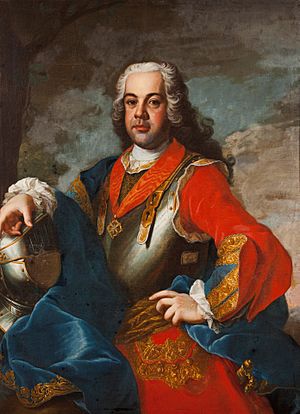
The next Pope, Innocent XIII, had been a representative of the Pope in Portugal before. He disliked the Society of Jesus (Jesuits) because of their power in Portugal. A big issue for Portugal was the Chinese Rites controversy, which was about the Jesuits' methods in Asia. Innocent's decision to stop the Jesuits' missions in China upset the Portuguese court.
Relations didn't get better with the next Pope, Benedict XIII, even though he was related to Portuguese royalty. John was unhappy with the Vatican's refusal of his requests. In 1728, he reacted by closing the Pope's office in Lisbon, calling back all Portuguese cardinals from Rome, and forbidding official contact between Portuguese people and the Pope. Benedict tried to solve the problems through the King of Spain, but John refused.
A key issue for John was the rank of the Pope's representative in Portugal. John wanted this position to be raised to a very high level and demanded to have a say in who was chosen. Both Clement XI and Innocent XIII had said no. It was only during the fourth Pope of John's reign, Pope Clement XII, that the issue was resolved in 1730. Clement XII agreed to John's demands, giving the Portuguese representative a special status shared only with France, Austria, and Spain. John's last Pope, Benedict XIV, had a much better relationship with the King. In 1748, the Pope gave John and his future successors the title "Most Faithful Majesty."
Ruling the Empire
During John's reign, the Americas became the most important part of the Portuguese Empire, as profits from Asia and Africa became less. Under John, the Portuguese Empire gained land in places like modern-day Brazil, India, Kenya, Uruguay, East Timor, Angola, and Mozambique. John wanted to control the government, trade, and communication in his overseas territories very strictly.
- Americas
Portuguese America was the top priority for John's empire. The colonies of Brazil and Maranhão became huge sources of wealth for the royal treasury. So, protecting and expanding Portuguese America was very important. Portugal also got back control of Uruguay after the Treaty of Utrecht in 1714 and successfully defended it against Spain in a war from 1735-1737.
In the 1690s, gold and diamonds were found in Brazil. But it was during John's reign that these resources were really used, with mining companies and tax systems set up. This led to a period known as the Brazilian Gold Rush. The "royal fifth" tax meant that one-fifth of all gold went directly to the King's treasury. To strengthen his power, John took direct control of two valuable provinces in Brazil: the Captaincy of São Vicente (in 1709) and the Captaincy of Pernambuco (in 1716). In 1721, John ordered the mining region to be separated into its own province, Minas Gerais (General Mines), to collect taxes more easily.
- Asia
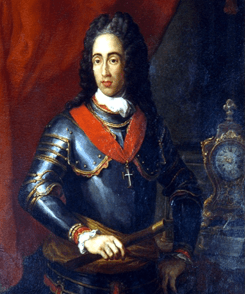
Asia used to be the main source of wealth for the Portuguese Empire, but its importance declined during John's reign as gold and diamonds from the Americas poured into Lisbon. Portuguese India faced economic problems, especially because of strict rules from the Portuguese Inquisition in Goa, which stopped trade with non-Christian merchants. Also, Portugal's main ally in India, the Mughal Empire, became much weaker after 1707, while the Maratha Empire, a long-time enemy of the Portuguese, grew stronger. Portugal lost some land after battles, but the size of Portuguese India actually tripled from 1713 to 1788 in a period known as the Novas Conquistas (New Conquests). Because Portuguese India became less important, its administration was changed many times during John's reign. For example, Portuguese Mozambique became independent from the Viceroy of Portuguese India, and a direct trade route was created from Portugal to Portuguese Macau (in modern-day China), skipping the stop in Goa.
- Africa
The Portuguese colonization of Africa was less important to John compared to the Americas and Asia. There were small conflicts with Dutch pirates blocking shipments to and from the Portuguese Gold Coast in the 1720s, which Portugal won. Tensions also rose with Britain in 1722 when British forces built a fort in Cabinda (in modern-day Angola), which Portugal had claimed since the 1400s. John ordered ships from the Armada do Brasil to go to Cabinda and either take the fort or destroy it. Portugal won in 1723. Portugal briefly took back Mombasa (modern-day Kenya) in 1728, but lost it again in 1729, ending Portugal's rule there.
John V's Cultural Impact
The Mafra Palace
John V is often remembered as one of the greatest supporters of the arts in Portuguese history. He ordered many building projects and artistic studies. His most famous and important work was the Royal Palace-Convent of Mafra. In early 1711, John was worried because he and Maria Anna of Austria had no children. He met with the High-Inquisitor of Portugal, Dom Nuno da Cunha e Ataíde, who promised the King that if he built a convent for Franciscans in Mafra, Maria Anna would have a child by the end of 1711. John agreed.
Construction began in 1717, with plans for a simple church convent. However, in the following years, with a huge amount of gold flowing in from the colonies of Brazil and Maranhão, the plans changed. It became a massive project, a "masterpiece" of John's reign. It was designed to house three hundred friars and also became a hybrid convent-palace, including a royal library, a large church, and many apartments for the royal family. A Swiss nobleman living in Portugal in 1726 noted the huge size of the project, saying that "King John has decided to build a second Escorial."
With the new plans for a palace complex, the Mafra project, led by royal architect João Frederico Ludovice, became more than just fulfilling a religious promise. It became a way to show the King's power and wealth. By 1729, over 15,000 workers from Portugal and its colonies, along with more than 6,000 soldiers, were involved in building the palace. While most of the palace was finished by 1730, John was so determined to complete it that he made it mandatory for everyone in the nearby villages of Mafra and Ericeira to work on the palace, unless they had a very good reason not to. Regarding the huge cost, the nobleman Merveilleux said that "three quarters of the royal treasury and nearly all of the gold brought on the fleets from Brazil were here, at Mafra, turned into stone."
Mafra stood as a symbol of royal power, even though it was mostly used as a pleasure palace and not a main seat of government. John ordered many operas, comedies, and concerts to be held at the palace with great ceremony. Its huge property became the royal family's favorite hunting grounds for centuries. In 1732, the King also started celebrating his birthday there every year. John housed one of the largest and most beautiful libraries in Europe within the palace, with over 36,000 books from the 14th to the 18th centuries. Work at Mafra continued until 1755, when the terrible Great Lisbon earthquake meant that all workers were needed to rebuild the city.
Patron of the Arts
Illness and Death
John V suffered from a condition called dropsy, which led to his death in 1750 at the age of 60.
Titles and Styles
| Royal styles of John V of Portugal |
|
|---|---|
 |
|
| Reference style | His Most Faithful Majesty |
| Spoken style | Your Most Faithful Majesty |
| Alternative style | His Majesty |
- October 22, 1689 – December 1, 1696: His Highness the Most Serene Infante João of Portugal
- December 1, 1696 – December 9, 1706: His Royal Highness the Prince of Brazil, Duke of Braganza, etc.
- December 9, 1706 – December 23, 1748: His Majesty the King of Portugal and the Algarves
- December 23, 1748 – July 31, 1750: His Most Faithful Majesty the King of Portugal and the Algarves
Genealogy
Ancestry
| Ancestors of John V of Portugal | |||||||||||||||||||||||||||||||||||||||||||||||||||||||||||||||||||||||||||||||||||||||||||||||||||||||||||||||||||||||||||||||||||||||||||||||||||||||||||||||||||||||||||||||||||||||||||||||||||||||||||||||||||||||||||||||||||||||||||||||||||||||||||||||||||||||||||||||||||||||||
|---|---|---|---|---|---|---|---|---|---|---|---|---|---|---|---|---|---|---|---|---|---|---|---|---|---|---|---|---|---|---|---|---|---|---|---|---|---|---|---|---|---|---|---|---|---|---|---|---|---|---|---|---|---|---|---|---|---|---|---|---|---|---|---|---|---|---|---|---|---|---|---|---|---|---|---|---|---|---|---|---|---|---|---|---|---|---|---|---|---|---|---|---|---|---|---|---|---|---|---|---|---|---|---|---|---|---|---|---|---|---|---|---|---|---|---|---|---|---|---|---|---|---|---|---|---|---|---|---|---|---|---|---|---|---|---|---|---|---|---|---|---|---|---|---|---|---|---|---|---|---|---|---|---|---|---|---|---|---|---|---|---|---|---|---|---|---|---|---|---|---|---|---|---|---|---|---|---|---|---|---|---|---|---|---|---|---|---|---|---|---|---|---|---|---|---|---|---|---|---|---|---|---|---|---|---|---|---|---|---|---|---|---|---|---|---|---|---|---|---|---|---|---|---|---|---|---|---|---|---|---|---|---|---|---|---|---|---|---|---|---|---|---|---|---|---|---|---|---|---|---|---|---|---|---|---|---|---|---|---|---|---|---|---|---|---|---|---|---|---|---|---|---|---|---|---|---|---|---|---|---|---|
|
|||||||||||||||||||||||||||||||||||||||||||||||||||||||||||||||||||||||||||||||||||||||||||||||||||||||||||||||||||||||||||||||||||||||||||||||||||||||||||||||||||||||||||||||||||||||||||||||||||||||||||||||||||||||||||||||||||||||||||||||||||||||||||||||||||||||||||||||||||||||||
Issue
| Name | Portrait | Lifespan | Notes |
|---|---|---|---|
| By Maria Ana of Austria (7 September 1683 – 14 August 1754; married by proxy on 27 June 1708) | |||
| Barbara, Queen of Spain |  |
4 December 1711 – 27 August 1758 |
Married Don Ferdinand VI of Spain. She had no surviving children. |
| Pedro, Prince of Brazil | 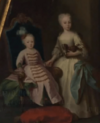 |
19 October 1712 – 29 October 1714 |
Was Prince of Brazil from birth until his death. |
| Joseph I of Portugal | 6 June 1714 – 24 February 1777 |
Became King of Portugal from 1750 to 1777. He married Mariana Victoria, daughter of King Don Philip V of Spain. They had four children. | |
| Infante Carlos of Portugal | 2 May 1716 – 1 April 1736 |
Died at age 19 from a fever. | |
| Peter III of Portugal | 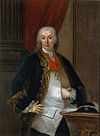 |
5 July 1717 – 25 May 1786 |
Became King of Portugal, jure uxoris (by right of his wife), from 1777 to 1786. He married his niece, Queen Dona Maria I of Portugal. Peter and Maria had six children. |
| Infante Alexandre of Portugal | 24 September 1723 – 2 August 1728 |
Died at age 4 from smallpox. | |
| By Luísa Inês Antónia Machado Monteiro | |||
| António of Braganza | 1 October 1714 – 14 August 1800 |
One of the three Children of Palhavã. John V recognized him and provided for him. | |
| By Madalena Máxima de Miranda (c. 1690 – ) | |||
| Gaspar of Braganza |  |
8 October 1716 – 18 January 1789 |
Was Archbishop-Primate of Braga from 1758 to 1789. One of the three Children of Palhavã. John V recognized him and provided for him. |
| By Paula de Odivelas (1701 – 1768 ) | |||
| José of Braganza |  |
8 September 1720 – 31 July 1801 |
Was High Inquisitor of the Portuguese Inquisition from 1758 to 1777. One of the three Children of Palhavã. John V recognized him and provided for him. |
| By Luísa Clara de Portugal (21 August 1702 – 31 August 1779) | |||
| Maria Rita of Braganza | 28 May 1731 – 27 November 1808 | A nun at the Convent of Santos in Lisbon. John V did not officially recognize her, but he paid for her expenses. | |
See also
 In Spanish: Juan V de Portugal para niños
In Spanish: Juan V de Portugal para niños
- List of Portuguese monarchs
- House of Braganza


